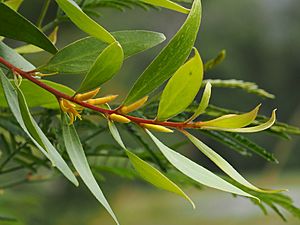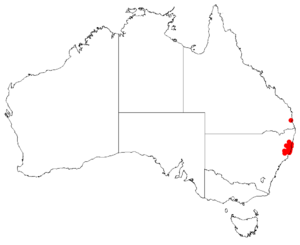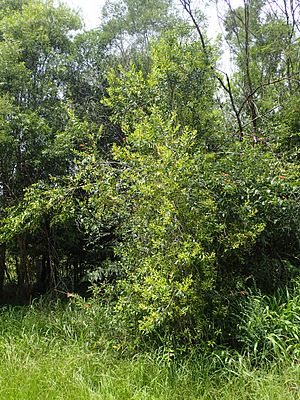Persoonia conjuncta facts for kids
Quick facts for kids Persoonia conjuncta |
|
|---|---|
 |
|
| Scientific classification | |
| Genus: |
Persoonia
|
| Species: |
conjuncta
|
 |
|
| Occurrence data downloaded from AVH | |

The Persoonia conjuncta is a type of flowering plant. It belongs to the Proteaceae family. This plant is endemic, meaning it only grows naturally in eastern New South Wales, Australia.
It can be a tall bush or a small tree. It has long, narrow leaves. Its flowers are yellow and shaped like tubes. These flowers grow in groups. After flowering, it produces green fruits.
Contents
What is Persoonia conjuncta?
Persoonia conjuncta is usually a tall shrub or a small tree. It can grow between 2 and 7 meters (about 6.5 to 23 feet) high. The bark on its trunk is smooth. Near the bottom, the bark might have small cracks.
Leaves and Flowers
The leaves of this plant are long and slender. They are shaped like a narrow oval or a spearhead. Each leaf is about 6 to 14 centimeters (2.4 to 5.5 inches) long. They are also about 1 to 2.6 centimeters (0.4 to 1 inch) wide.
The flowers are bright yellow. They grow in groups of up to sixteen flowers. These groups are found along a stem called a rachis. This stem can be up to 14 centimeters (5.5 inches) long. After the flowers bloom, the rachis grows into a leafy shoot. Each flower sits on a small stalk called a pedicel. These stalks are about 2 to 6 millimeters long. The flower parts, called tepals, are 12 to 13 millimeters long. They feel hairy on the outside.
When it Flowers and Fruits
Persoonia conjuncta flowers during January and February. After the flowers, it grows a green fruit. This fruit is a type of drupe, which means it has a hard pit inside.
Where Does Persoonia conjuncta Grow?
This special plant, also known as a geebung, lives in forests. You can find it along the coastal mountain ranges. It grows in the area around Coffs Harbour. Its range extends south to the Manning River. All these places are in eastern New South Wales.
How Was This Plant Named?
The Persoonia conjuncta was officially named in 1991. Two scientists, Lawrie Johnson and Peter Weston, described it. They published their findings in a science journal called Telopea.
Lawrie Johnson first collected samples of this plant. He found them on Mount Yarrahapinni in 1980. This mountain is near a town called Kempsey.

